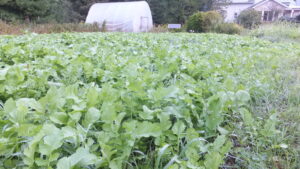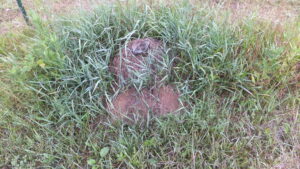Did you ever wonder about what the tests proved that you took in school? I know I have! If soil tests seem as elusive in results as your past test scores; this article is for you!
A recent client had submitted soil samples from their small farm for analysis. When they got the lab report back, they were unsure of the next steps and contacted me.

This fall planting of daikon radish on our property provides food for people, discourages weeds, can be tilled in for added organic material and the foot-long roots aerate the soil
After reviewing the lab report, I performed a site assessment. A site assessment looks at other factors that are not included in a normal soil test. Visually apparent attributes of the site like slope, exposure, existing vegetation and actual use of the property are things that I consider in a site assessment. The site assessment provided me with information that in conjunction with the soil test, gave the whole picture of what was happening.
In this case the soil test results recommended applying a hundred pounds or more of nitrogen per acre, depending on the desired crop. However, I found a dense stand of clover in one field. The clover will provide all of the nitrogen the site will need when it is plowed in. In the interim, the clover can be cut and used for feed without reducing the nitrogen potential because clover is a naturally nitrogen fixing plant.

Even ants can improve the soil. The ants that formed this large ant hill in our tree nursery are loosening and incorporating organic mater into the soil. Note how the grasses are greener closer to the mound as the ants have helped release nutrients and increased water holding capacity of the soil
The soil test results indicated a high level of phosphorus. During the assessment I noted that there is a pond on this property. Because of this, special attention to reducing water runoff that can contain high levels of phosphorus is warranted. Phosphorus is the main ingredient that leads to algae and plant growth in bodies of water and the client desires good water quality in the pond.
According the the lab report, soil samples also contained about 2% organic mater. The client told me their goal is to have a farm that uses limited amounts of synthetic pesticides and fertilizers. While 2% organic material might be viewed as “good” for conventional farms; increasing the amount of organic material in the soil on this farm will reduce the need for synthetic fertilizers, water and other inputs.
Because healthy soil is such an important part of sustainable property management; look for more articles to follow on how you can take advantage of existing soil conditions, what you can do to build soil and how site assessments are the key to understanding your property. All of this without taking a test!

